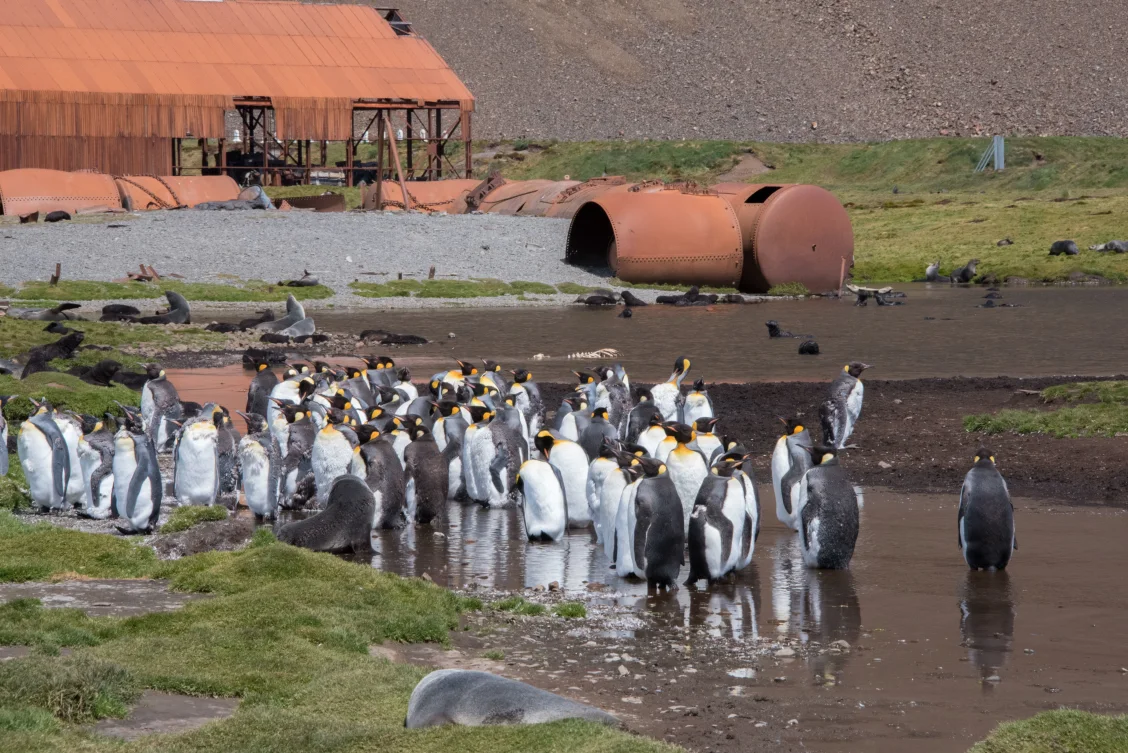Removing Hazardous Waste from Abandoned Whaling Stations on South Georgia
With fuel oil and asbestos lingering from the whaling era, the South Georgia Heritage Trust is planning an ambitious project to make parts of the island safer for wildlife and people.
Alone in the mighty South Atlantic Ocean, South Georgia Island is so isolated that few people have ever set foot here. Yet its very remoteness has been its attraction for some. Since its discovery in 1775, the protected bays of this ocean outpost have offered lucrative rewards to hunters of seals and whales, and a gateway to the Antarctic for explorers including Sir Ernest Shackleton.
In this relatively short timeframe, we humans have nevertheless left our mark. As the whale trade flourished, so did the industrial waterfront dwellings on South Georgia where ships would shelter, and their bounty was processed. But when whaling stopped here in 1966 – due to dwindling whale numbers – there was no longer a financial incentive to maintain the whaling stations. These decaying outposts of the industry were simply abandoned in this formerly pristine environment, out of sight and out of mind.
Rusting relics pose multiple dangers
Today, visitors to South Georgia are confronted with rusting relics; stark reminders of how nature was once exploited here on a monumental and unsustainable scale. Rickety wooden docks jut out into the water. Sheet metal roofs sit atop weathered old buildings, some partially fallen down. Meanwhile, all around lies detritus from the dark trade that took place here: steel cables snake along the beach and around the seals who come here to rest, birds line their nests with debris, and vast decaying industrial tanks hide remnants of oils and chemicals.
From previous investigations, the South Georgia Heritage Trust (SGHT) know that some of the tanks and pipes hold heavy oil that will eventually leak. They also know that other debris and materials including asbestos could be hazardous to people and wildlife alike. Moreover, its presence currently prevents visitors from accessing some areas such as the old whaling station of Stromness.
Scoping South Georgia’s restoration
To benefit the island’s wildlife and human visitors alike, the SGHT is planning an ambitious project. This aims to clean up fuel oil, asbestos, and other hazardous debris from some of the abandoned whaling stations, in collaboration with the South Georgia Government (GSGSSI) and other partners.
As a first step, an expert survey team will travel to South Georgia in November 2022 to scope and cost the work needed to make these sites safer. With help from the Hurtigruten Foundation NOK 50,000 (approx. USD 5,150), the team will charter the MV Hans Hansson for a month to make the voyage.
The multidisciplinary survey team will comprise 12 specialists from Norway, the UK, and the Falkland Islands, including experts in asbestos remediation, oil remediation, and heritage restoration, along with a structural engineer, documentary film maker, architect, SGHT representative, and expedition leader. Together they will identify the challenges that would be faced during a clean-up operation and prepare a detailed feasibility report and costed plan for the works.
Building on previous success against rodents
Once the survey is complete, its findings will inform the major environmental and heritage conservation work that the SGHT plans to undertake over the next five years.
As such, the 2022 survey project is one part of a sustained effort to restore South Georgia and save its heritage. In fact, the island is currently undergoing an extraordinary biological renaissance. The SGHT’s decade-long Habitat Restoration Project – also supported by Hurtigruten Foundation – has played a key role in this transformation by eradicating invasive rodents which preyed upon native birds.
Now, the new survey will give the SGHT the specialist information it needs to roll back yet more of the historical damage that humans have caused to the once pristine environment of South Georgia.
Historical conservation of buildings
As well as protecting the environment of South Georgia, the SGHT also wants to restore some of the historic buildings that tell the history of the site.
With this in mind, the 2022 survey team will also establish the feasibility of stabilising and restoring certain key historic buildings, such as the Stromness Manager’s Villa, which even hosted Sir Ernest Shackleton himself. The great explorer actually died at South Georgia and lies buried in the graveyard at Grytviken.
Saving heritage like this will help establish the future of this fascinating island as a place where visitors can immerse themselves in the past. By restoring these historical structures and making them sustainable, modern adventurers will be able to come and learn about this important outpost in the history of exploration for centuries to come.
South Georgia Heritage Trust
The South Georgia Heritage Trust (SGHT) aims to work with all who wish to preserve the island’s natural and historical heritage for future generations – to redress past damage to its environment, to protect its wildlife now and in the future, and to preserve the human heritage of the island which so clearly shows the best and worst of humanity.
Where can I learn more?
You can see more on the South Georgia Heritage Trust website
